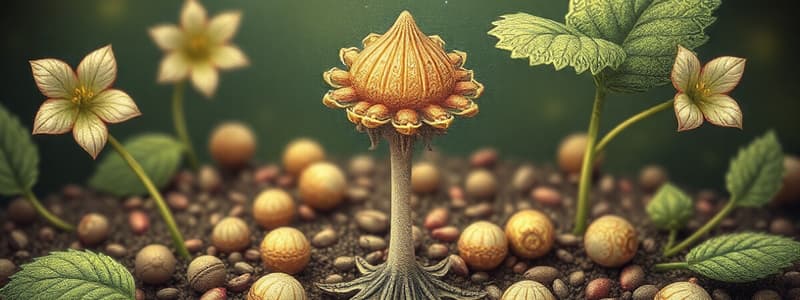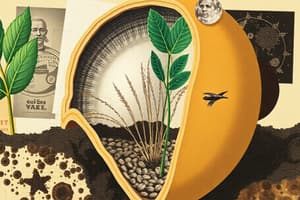Podcast
Questions and Answers
Explain how seed germination is crucial for both crop yield and quality.
Explain how seed germination is crucial for both crop yield and quality.
Seed germination is the fundamental process by which plants grow from a single seed and directly determines the success of crop establishment, influencing both the quantity (yield) and the desired attributes (quality) of the harvest.
Describe the protective function of the seed coat and its composition.
Describe the protective function of the seed coat and its composition.
The seed coat is the outermost covering of a seed that provides physical protection against environmental factors and pathogens. It typically consists of two layers and is the solid component of the seed.
What is the role of the endosperm, and how does it differ between monocotyledonous and dicotyledonous seeds?
What is the role of the endosperm, and how does it differ between monocotyledonous and dicotyledonous seeds?
The endosperm is a tissue inside seeds that stores food to nourish the developing embryo. It is bulky and generally present in monocotyledonous seeds, whereas dicotyledonous seeds often have little to no endosperm, as the cotyledons take over the food storage function.
What are the three main components of the plant embryo and mention what each component eventually develops into?
What are the three main components of the plant embryo and mention what each component eventually develops into?
Compare and contrast endospermic and non-endospermic seeds.
Compare and contrast endospermic and non-endospermic seeds.
How does water serve as a critical factor in germination, affecting enzymatic activity?
How does water serve as a critical factor in germination, affecting enzymatic activity?
Explain the dual role of light in seed germination.
Explain the dual role of light in seed germination.
Describe the importance of oxygen in cellular respiration during germination.
Describe the importance of oxygen in cellular respiration during germination.
How can soil temperature impact germination, and why is an optimal temperature crucial?
How can soil temperature impact germination, and why is an optimal temperature crucial?
What is seed dormancy, and how can it be advantageous or disadvantageous?
What is seed dormancy, and how can it be advantageous or disadvantageous?
Explain how the elongation of the hypocotyl contributes to epigeal germination.
Explain how the elongation of the hypocotyl contributes to epigeal germination.
Describe the fate of the cotyledons in epigeal germination.
Describe the fate of the cotyledons in epigeal germination.
How does the epicotyl contribute to hypogeal germination?
How does the epicotyl contribute to hypogeal germination?
What are some key differences between hypogeal and epigeal germination?
What are some key differences between hypogeal and epigeal germination?
In hypogeal germination, what part of the plant emerges from the soil, and where do the cotyledons remain?
In hypogeal germination, what part of the plant emerges from the soil, and where do the cotyledons remain?
What is the significance of stored food in seeds for successful germination and seedling establishment?
What is the significance of stored food in seeds for successful germination and seedling establishment?
Explain how temperature affects not only the germination percentage but also the rate of germination.
Explain how temperature affects not only the germination percentage but also the rate of germination.
Why is adequate and continuous supply of water necessary for complete emergence during seed germination?
Why is adequate and continuous supply of water necessary for complete emergence during seed germination?
Describe what happens to the seed coat after the hypocotyl straightens during epigeal germination.
Describe what happens to the seed coat after the hypocotyl straightens during epigeal germination.
How do monocotyledonous and dicotyledonous embryos differ, particularly in the number of cotyledons?
How do monocotyledonous and dicotyledonous embryos differ, particularly in the number of cotyledons?
Flashcards
Seed Germination
Seed Germination
The process by which plant species grow from a single seed into a plant, influencing crop yield and quality.
Seed
Seed
A plant enclosed in a covering called the seed coat, usually with stored food.
Seed Coat
Seed Coat
Outermost covering of a seed with two layers.
Endosperm
Endosperm
Signup and view all the flashcards
Embryo
Embryo
Signup and view all the flashcards
Radicle
Radicle
Signup and view all the flashcards
Plumule
Plumule
Signup and view all the flashcards
Water importance in germination
Water importance in germination
Signup and view all the flashcards
Seed Dormancy
Seed Dormancy
Signup and view all the flashcards
Epigeal germination
Epigeal germination
Signup and view all the flashcards
Hypogeal Germination
Hypogeal Germination
Signup and view all the flashcards
Study Notes
- Seed germination is a crucial phase of plant growth and development.
- Germination is the fundamental process of plant species growing from a single seed.
- Germination influences crop yield and quality.
- A common example of seed germination is the sprouting of a seedling from a seed of an angiosperm or gymnosperm.
What is the Seed
- A seed is a small embryonic plant enclosed in a seed coat, typically with stored food.
- Seeds are the product of the ripened ovule of gymnosperm and angiosperm plants.
- Seed development occurs after fertilization and some growth within the mother plant.
Seed Types and Structure
- Seeds have two primary types: monocotyledonous and dicotyledonous.
- Monocotyledonous seeds examples: wheat and maize.
- Dicotyledonous seeds examples: Beans and castor.
Structure of Seed
- The seed coat is the seed's outermost covering with two layers, generally a solid component.
- The endosperm is a bulky tissue produced inside seeds that stores food.
- Monocotyledonous seeds are generally endospermic, while some, like orchids, are non-endospermic.
- Seeds divide into endospermic and non-endospermic types.
- The embryo is small and situated in a groove at one end of the endosperm.
- The embryo develops after a fertilized stage.
- The main parts of the embryo are the radicle, plumule, and cotyledon.
- Radicle- growth becomes the root system under the soil surface
- Plumule- groth becomes the shoot system above the soil surface
- Cotyledons are often fleshy and full of reserve food materials.
- There are two types of cotyledons present in flowering plants:
- Monocotyledonous/monocots feature embryos with one cotyledon.
- Dicotyledonous/dicots feature embryos with two cotyledons.
Germination Factors
- Water is the most important factor in germination.
- Continuous water supply is necessary for complete emergence.
- Water triggers enzymes for starch conversion into sugar.
- Light is another key germination factor and can stimulate or inhibit seed germination.
- Oxygen is necessary in the presence of enough moisture for cellular respiration, which allows start of metabolism and for plants to grow.
- A favorable temperature is necessary for plant growth and affects germination percentage and rate.
- Each seed species has an optimal soil temperature for germination.
- Seed dormancy is a condition preventing seeds from germinating even under favorable conditions to complete maturity.
Types of Germination
- Epigeal Germination: Cotyledons are brought above ground due to rapid hypocotyl elongation; cotyledons fall down ultimately
- Hypogeal Germination: Cotyledons remain below the soil surface as the epicotyl elongates, pushing the plumule out of the soil.
Studying That Suits You
Use AI to generate personalized quizzes and flashcards to suit your learning preferences.




